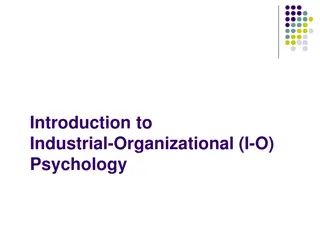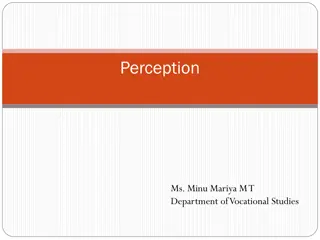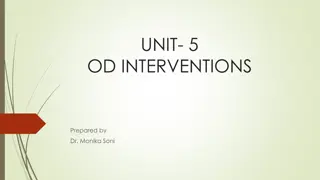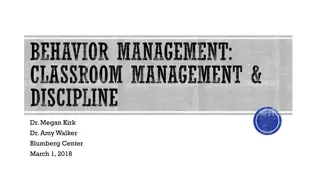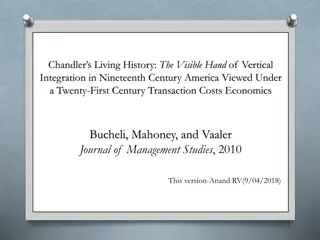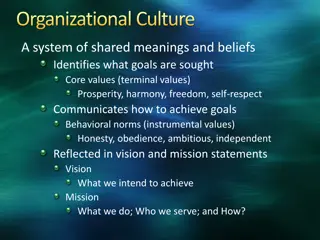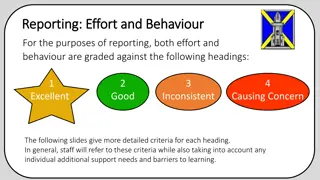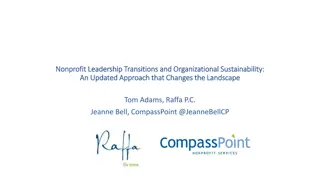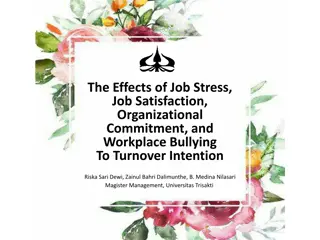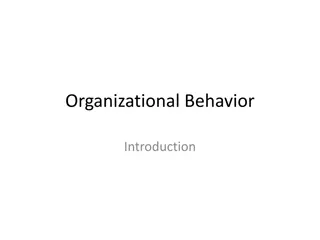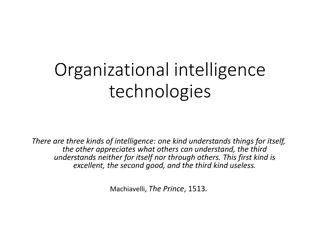Understanding Organizational Behavior and Characteristics
Organizational behavior explores how individuals behave in various contexts such as child, IPS officer, businessman, etc. An organization is a consciously coordinated unit comprising two or more individuals working towards common goals. Characteristics of an organization include deliberate creation, hierarchy, coordination, and continuous functioning. Behavior is a response influenced by personal and environmental factors. Overt and covert behaviors are key aspects studied in organizational behavior.
Download Presentation

Please find below an Image/Link to download the presentation.
The content on the website is provided AS IS for your information and personal use only. It may not be sold, licensed, or shared on other websites without obtaining consent from the author. Download presentation by click this link. If you encounter any issues during the download, it is possible that the publisher has removed the file from their server.
E N D
Presentation Transcript
Organizational Behaviour People behave differently in different situations or environment - Child - IPS Officer - Businessman - Professor - Medical Officer - Collector etc etc
What is organization? Stephen P. Robbins and Timothy A. Judge s Definition Organization is a consciously co-ordinated social unit, composed of two or more people, that functions on a relatively continuous basis to achieve a common goal or a set of goals .
Characteristics of an Organization An organization is created deliberately or consciously. Anything which is formed as a natural sequence such as a family or a tribal group may not be termed as an organization. Typical organizations are manufacturing companies, marketing firms, trading houses, transport offices, banks, colleges, hotels, hospitals, etc., It is composed of two or more people. Any business run by one individual cannot be termed as a business organization. In large organizations the number of people runs into lakhs. There is co-ordination among the people working in an organization. In the absence of co-ordination/co-operation among the people the organization gets disorganized and ceases to exist. There is hierarchy in any organization. A typical hierarchy consists of Board of Directors, Chairman, Managing Director, General Managers, Dy. General Managers, Senior Managers, Managers, Supervisors and Workers in a large manufacturing firm. Principal, Heads of Departments, Professors, Associate Professors and Asst. Professors form the hierarchy in a professional college. Each level of hierarchy will have its own authority and responsibility. Organizations function continuously. There are business houses existing for over centuries. In certain cases the business may be seasonal [selling of crackers, marketing of a particular variety of fruit and etc.,] but still it is organized business. organization will have certain goal(s). For a hospital, the goal could be to offer quality medical service at an affordable cost. A star hotel s goal could be to offer a luxurious stay. The goal of a management school could be to make the students industry-ready. Depending on the top management the goals of a corporate could be to offer quality goods/service, invent newer and newer product designs, sell products at the cheapest rate or make available its services round the clock. Every Show Picture
Behaviour Behaviour is a response to a stimulus which is observed directly or indirectly. Human behaviour is a function of person and environment i.e. B=f [PxE]. Person includes education, skills, experience, health, gender, age, attitude, aptitude, beliefs, perception, personality, etc., Environment covers working conditions, amenities, supervision, rewards, fellow workers, motivation etc.
Behaviour: Overt and Covert Overt behaviour: It is what a person does. It is the observable and measurable activity of human beings. It includes mental process like decision making or physical process like handling a machine. Covert behaviour: This cannot be easily observed or measured (e.g.) feelings, attitudes, perception, etc.,
Meaning of Organizational Behavior Organizational behaviour is the study of what people think, feel and do in and around organizations. It is also a systematic study of individual, team and organization-level characteristics in an organization
Definition of Organizational Behaviour According to Stephen P. Robbins, organizational behaviour is a field of study that investigates the impacts that individuals, groups and structure have on behaviourwithin organizations for the purpose of applying such knowledge toward improving an organization s effectiveness. Fred Luthans defined organizational behaviouras the understanding, prediction and management of human behaviour in organizations
Goals of Organizational Behaviour Study The goals of understanding organizational behavior are to describe [how people behave under a variety of conditions /environments?] to understand[why people behave as they do in different situations?] to predict [how people behave in future?] and to control [how their behaviour is controlled or managed for productive activity] Show picture
Nature of Organizational Behaviour study It is a part of management study representing behavioural approach to management It is a human tool for human benefit. It is interdisciplinary. That is, it is a field of study involving the integration of behavioural sciences such as psychology, sociology, anthropology etc., It is not a discipline in the usual sense. It is an applied science seeking to fulfill employees needs and organizations objectives. It involves individual / group behaviourand behaviourof organization itself. It is humanistic as well as optimistic. It is normative and value centered. While positive science suggests only cause-effect relationship, normative science prescribes how the various findings can be applied to get organizational results which are acceptable to society. It is mostly oriented towards organizational objectives. It is a total system.
Limitations of Organisational behaviour Lack of Unified theory 1. 2. Behavioural Bias 3. Law of diminishing returns 4. Unethical Manipulation of people
Role of Organisational Behaviour Understanding Human Behaviour 1. 2. Controlling Human Behaviour 3. Organisational Adoption
Understanding Human Behaviour Individual level 1. 2. Interpersonal Level 3. Group level 4. Intergroup Level
Controlling Human Behaviour Use of Power and Sanction 1. 2. Leadership 3. Communication 4. Organisational Climate
Organisational Adoption This refers to the total organisational situations affecting Human Behaviour
Nature of Human behaviour S-R Model (show diagram Fig 2) 1. 2. S-O-R Model [stimulus-organism(sense,nervous, muscles & glands)-response] (show pictures on chapter 2 29,30,32,33) 3. S-O-B-C Model S Overtand Covert stimuli C O B Overt and Covert consequen ces Physiological being and cognitive mediator Overt and Covert behaviour
Individual Differences People differ in the importance they attach to intrinsic rewards to the job. 2. People differ in the type of compensation plan they want or desire. 3. People differ in the style of supervision. 4. People differ in their preferred schedules of work hour. 5. People differ in their tolerance for stress. 1.
Foundations of Individual behaviour Factors in Individual Behaviour 1. Physiological a. Intelligence b. Physical Abilities c. Age d. Gender e. Race 2. Socio-psychological a. Personality b. Perception c. Learning d. Attitudes and values e. Emotional Intelligence f. Motivation
Factors causing individual differences Individual behaviour is caused by 1. Individual Variables A. Physiological variables B. Socio-psychological variables 2. Situational Variables A. Organisational Variables B. Job Variables
1. Individual Variables A. Physiological variables i. Intelligence ii. Physical abilities iii. Age iv. Gender v. Race B. Socio-psychological variables i. Personality ii. Perception iii. Learning iv. Attitudes and values v. Emotional Intelligence vi. Motivation
2. Situational Variables A. OrganisationalVariables i. Organisational structure ii. Organisational processes iii. Organisational culture B. Job Variables i. Nature of Job ii. Work Environment
PERSONALITY The term personality has been derived from the Latin word persona which means to speak through. This Latin term denotes the masks which the actors used to wear in ancient Greece and Rome
Personality should include: - external appearance and behaviour - inner awareness of self as a permanent organizing force and - particular pattern of measurable traits, both inner and outer.
Definition of Personality Personality cannot be defined precisely. There are many definitions - Personality is the sum total of characteristic pattern of thinking, feeling and behaving that constitutes the individual s distinctive method of relating to environment.
Determinants of Personality The determinants of personality are: Biological factors Family and social factors Cultural factors and Situational factors
Determinants of Personality Biological Factors Family and Social Factors Individual Personality Situational Factors Cultural Factors
1. Influence of biological factors on personality Heredity 1. 2. Brain 3. Physical features
2. Influence of family/social factors on Personality Socialization 1. 2. Identification process Home environment Family members Social groups a. b. c. show picture on chapter 4, pg 76 & 77
3. Cultural factors and personality - Culture is the underlying determinant of human decision making. It generally determines attitudes toward independence, aggression, competition and co-operation. - Each culture expects and trains its members to behave in the ways that are acceptable to the group. - To a greater extent, the child s cultural group decides its values / characteristics through group learning show picture on chapter 4, page 77
4. Influence of situational factors on personality The S-O-B model of human behaviour gives more importance to situations. Research studies have suggested that situation plays a powerful role in human personality. Situations bring in pressure to influence one s personality. Example. A care-free son becomes highly responsible when his father, the only bread winner in the family, dies. The situation, i.e. death of father, has transformed an irresponsible son into a responsible person.
Traits of Indian Managers Indian managers generally exhibit the following traits Indian mangers are somewhat emotional, casual, sensitive, tough, tense and group dependant 2. On two personality characteristics of authoritarianism and machivelliansm 3. They have need for achievement and competence though they have lower level of maturity and persistency 4. They show co-operation, friendliness, sympathy and nurturance. 1.
UNIT 2 PERCEPTION What is perception? Perception is a process by which individuals organize and interpret their sensory impressions to give meaning to their environment. Perception could be explained in various ways. It is the process of receiving information about and making sense of the world around people. It is also the process of deciding which information to notice, how to categorize the noticed information, and how to interpret it within the framework of one s existing knowledge. In simple terms, perception is how one looks at the world SHOW PICTURE ON PAGE 99 CHAPTER 5
Factors that influence perception Show fig 32 on page 100 chapter 5
Perceptual process Perceptual process consists of several sub-processes. It is an input-output process. Here, the stimuli, namely, the environment, subject, events or people can be considered as inputs. These inputs are processed through selection, organization, and interpretation. The outcomes are opinions, feeling and attitudes etc. which ultimately decide the behaviour of the people.
Simplex and complex process of Perception show fig 24a and fig33 on page 101 chapter 5
Factors influencing perceptual selectivity Perception is a selective process as people can select only a limited amount of information in the environment. Through selection, certain aspects of stimuli which are admitted /accepted remain in the minds of people for interpretation. For example, when people read newspapers, they do not read all the columns; they concentrate on the items in which they are interested. Perceptual selectivity is caused by two categories i.e. external and internal
External factors in perceptual selectivity Size Intensity Repetition Familiarity Novelty Contrast Motion
Internal factors in perceptual selectivity Self concept Beliefs Expectations Inner needs Response disposition Response salience Perceptual defense
Developing Perceptual Skills Empathy is a person s understanding and sensitivity to the feelings, thoughts and situation of others. Empathy has both cognitive [thinking] and emotional component. The cognitive component, sometimes called perspective thinking, represents a cognitive awareness of another person s situational and individual circumstances. Empathizing with others improves a person s sensitivity to external causes of another person s performance and behaviour, thereby reducing fundamental attribution error. Empathy towards others improves through feedback. Improving empathy is putting oneself in the other person s shoes. That is, placing oneself in the opposite party s situation and then arguing. The more a person personally experiences the environment in which other people live and work, the better he will understand and be sensitive to their needs and expectations.





